Giochi dell'Oca e di percorso
(by Luigi Ciompi & Adrian Seville)
(by Luigi Ciompi & Adrian Seville)

|
Giochi dell'Oca e di percorso
(by Luigi Ciompi & Adrian Seville) |

|
 |

Torna alla ricerca giochi (back to game search) |
 |
| Tramway Spel (Van Houten's Cacao) | ||
 |
Versione stampabile
 |
Invia una segnalazione

|
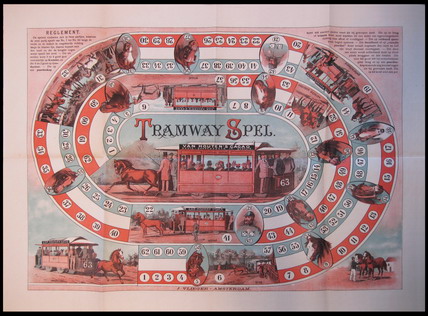 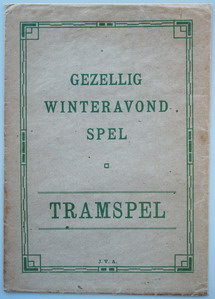   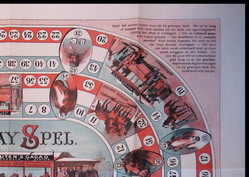 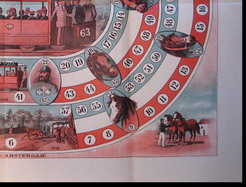 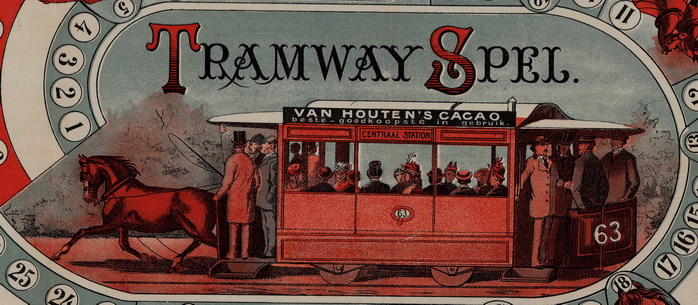 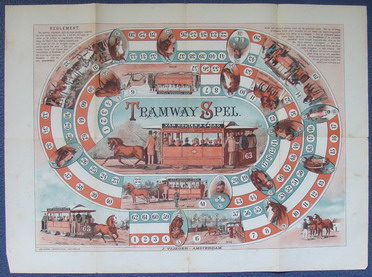 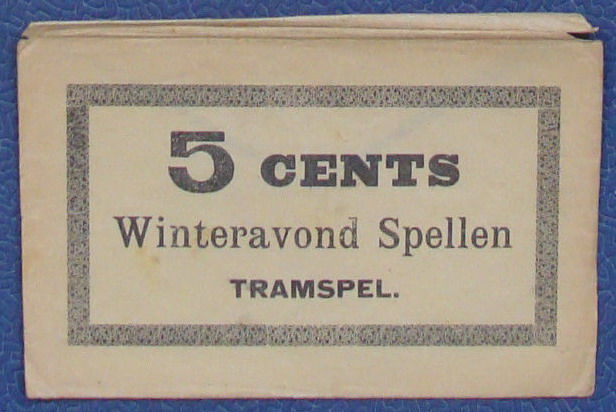  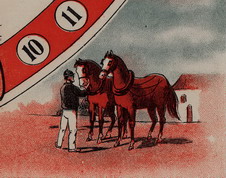    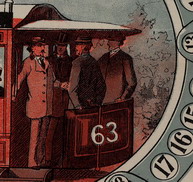 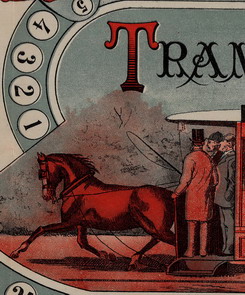 |
primo autore: | Anonimo |
| secondo autore: | Vlieger J. | |
| anno: | 1885ca | |
| luogo: |
Olanda-Amsterdam |
|
| periodo: | XIX secolo (4°/4) | |
| percorso: | Percorso doppio di 63 caselle numerate | |
| materiale: | carta (paper) (papier) | |
| dimensioni: | 430X590 | |
| stampa: | Cromolitografia | |
| luogo acquisto: | ||
| data acquisto: | ||
| dimensioni confezione: | ||
| numero caselle: | 63 | |
| categoria: | Ferrovie, Tramway, Metropolitana | |
| tipo di gioco: | Gioco di percorso | |
| editore: | Van Houten'Cacao | |
| stampatore: | Drukkerij Senefelder, Amsterdam | |
| proprietario: | Sinninghe Damsté Christine - L. Ciompi | |
| autore delle foto: | Sinninghe Damsté Christine - L. Ciompi | |
| numero di catalogo: | 1523 | |
| descrizione: |
Gioco con doppio percorso di 63 caselle numerate. REGOLE: in alto a destra e a sinistra. CASELLE: mute. REFERENZA 1 Tramway-Spiel Amsterdam, um 1885 Lithografie, kolorielt, 36X50 cm Verlag: J. van Vlieger Die sehr erfolgreichen Strassenbahnspiele erschienen ab Mitte des 19, Jahrhunderts in fast identem Design in vielen Sprachen, unter anderem auf Franzoesisch, Italienisch und Japanisch. Die Pferdebahnen auf Schienen beschleunigten den urbanen Verkehr durch die geringere Haftreibung zwischen Rad und Fahrbahn und verdraengten den bis dahin gebraeuchlichen Pferde-Omnibus. Die Ausbreitung der Schienennetze veraenderte den Stadtraum massiv indem sie den Strassenraum verengte; "oeffentlich" war die Strassenbahn nur bedingt, indem Ausbau wie Betrieb den oekonomischen Interessen ihrer privaten Betreiber folgten, Die Entwicklung des Spiels repraesentiert auch den technischen Fortschritt des Verkehrs: Zunaechst wurden Strassenbahnen mit Pferdetraktion abgebildet, dann elektrische Strassenbahnen. 1882 eroeffnete in Berlin-Charlottenburg die erste Tramstrecke mit elektrischer Oberleitung, danach bestimmten die "Elektrischen" den Nahverkehr in den europaeischen und amerikanischen Metropolen und etwa ab 1900 auch die Bildwelten der Stadtspiele (siehe Abb). Beim hollaendischen Tramway Spel handelt es sich um eines der ersten Werbespiele, und zwar im Sinn modernen Product-Placements. Das Spiel zeigt am Zielfeld 63 eine Strassenbahn, die wie zufaellig das Werbebanner fuer Van Houten’s Cacao traegt (vgl. Abb. 9, Einleitung, S.14). Die Regeln folgen dem klassischen Gaensespiel, die Ereignisfelder sind durch Abbildungen bestimmt. Die Besonderheit der Spielmechanik besteht darin, dass entlang der Spirale in unterschiedlicher Richtung gespielt wird, von innen nach aussen und umgekehrt - eine durchaus stimmige Loesung: Die Strassenbahnlinie verkehrt in zwei Richtungen. Spielregeln Die Spieler teilen sich in zwei Gruppen auf, von denen die eine Gruppe von Feld 1 bis 63 entlang der roten und die andere in entgegengesetzter. Richtung entlang der blauen Linie spielt, danach bestirnrnt man den Einsatz, und wer am hoechsten vvirft, beginnt. - Wer als ersten Wurf 5 + 4 wuerfelt, geht unverzueglich auf Kutscher (42 rot bzv. 21 blau), und wer 6 + 3 wuerfelt, auf Schaffner (21 rot / 42 blau), - Wer auf einen Pferdekopf kommt (5, 9, 14, 18, 27, 31, 36, 45, 50, 54, 58 rot / 5, 9, 13, 18, 27, 32, 36, 45, 49, 54, 58 blau),verdoppelt die Augenzahl seines Wurfs. Wer auf die Bruecke (6 rot bzw. 57 blau) oder Weichen (22 rot / 41 blau, 6 rot / 57 blau) kommt, muss warten, bis ein anderer Spieler aus der entgegengesetzten Richtung ihn abloest oder an ihm vorbeigeht. - Wer auf das Feld falsches Gleis (32 rot / 31 blau) kommt, muss von vorne beginnen. - Wer entgleist (19 rot / 44 blau) oder auf das Feld frische Pferde (52 rot / 11 blau) kommt, bezahlt erneut den Einsatz und muss einmal aussetzen. - Wer von einem anderen eingeholt wird (geschlagen wird), muss auf dessen Platz zurueckgehen und einmal den Einsatz bezahlen. Wer ueber 63 hinaus wuerfelt, muss um die Zahl zurueckgehen, die er zu viel geworfen hat, und wer dabei auf einen Pferdekopf kommt, noch einmal um so viel, wie er gewuerfelt hat. Wer als Erster auf 63 kommt, gewinnt den Pot. (Ernst Strouhal) REFERENZA 2 Game 55: Tramway Game Tramway Spel. Amsterdam: J. Vlieger, [c. 1885]. Lithograph in black, red and blue, 36 x 50 cm. Refs.: Ciompi/Seville 1523; Buijnsters, p. 266. D’Allemagne notes the first occurrence of a French Jeu du Tramway at about 1855. Thereafter, several editions are found in France, Germany, Italy and the Low Countries: these continue into the 20th C, with updating to electric propulsion instead of the original horses. The present Tramway Game was published by the Amsterdam firm of J. Vlieger in about 1885 for the Dutch firm of van Houten, manufacturers of drinking chocolate. Like all other editions, it is a two-track variant of the Game of Goose, played with the usual double dice. Here, the red track is followed counterclockwise towards the center (as in normal Goose), while the blue track runs clockwise away from the center. The favorable goose-type spaces, where the throw is doubled, are indicated by horses’ heads, in two interwoven sequences. The dice spaces are represented by the conducteur (conductor) and koetsier (coachman). The traditional hazards of Goose have been adapted cleverly to the problems of the tramway. The death space (”start again”) has its equivalent in the verkeerd spoor (wrong track) spaces, at 32 red and 31 blue, which show two trams meeting head on. The Goose prison and well hazards have their counterparts in the brug (bridge) and wissel (crossing) spaces, the rule ”wait until released by another” being given added piquancy by requiring that the release must be made by a player from the team of the opposite color, who then has to wait in turn. This waiting for the oncoming tram at a single-track bridge or a crossing point must have been all too familiar in real life. Finally, the delays of the Goose inn and the labyrinth have their counterparts in the derailleert (derailed) and the versche paarden (fresh horses). The Tramway Game is both realistic and playable and indeed must have been popular, judging by the number of new editions over the years. The Vlieger game distinguishes itself from other, non-promotional, versions by having an advertising slogan on the tramcar: “Van Houten’s Cacao – beste goedkoopste in gebruik” (Van Houten’s drinking chocolate – best and cheapest in use). This is an example of the simplest way of adapting a game for advertising purposes -just add a distinctive slogan. (Adrian Seville) REFERENZA 3 La gestione dei trasporti di persone per mezzo dei tramway a trazione animale inizialmente era affidata agli imprenditori privati che disponevano di ingenti somme di capitale da investire soprattutto nella creazione dei binari. Le leggi del mercato prevedevano anche la possibilità di utilizzare le vetture come vetrina concorrenziale per pubblicizzare prodotti di tendenza. L’effetto era maggiormente efficace in quanto la diffusione del tramway per il trasporto urbano aveva richiesto la creazione di più linee in rapporto alla dimensione delle città. L’editore J. Vlieger di Amsterdam documentava questa contaminazione fra grande industria e promozione commerciale nel periodo 1885-1890 pubblicando un interessante gioco dal solito titolo "Tramway Spel", il primo, forse, dei giochi di pubblicità. (Arch. n°383, Arch. n°1523, Arch. n°1839). Vlieger, rimaneggiando il gioco edito da Ellerman, inserisce sui lati esterni delle vetture il banner pubblicitario del cacao “Van Houten”, definendolo “best - goedkoopste in gebruik” (il migliore ed il più economico in commercio). Inoltre, denomina le vetture con riferimento alle diverse linee di percorso, come si può vedere con le vetture n. 63 che percorrono la linea “Central Station” – periferia, o, nelle due caselle di scambio (wissel) con la vettura n. 22 “Amstel Dijm”, casella 41 (linea rossa) - 22 (linea azzurra), e la vettura n. 2 “Sarphatistraat”, casella n. 57 (linea rossa) – 6 (linea azzurra). Il gioco qui riprodotto non indica il tipografo, mentre altri due esemplari in tutto uguali sono stati realizzati dagli incisori di Amsterdam Amand Lith e Drukkerij Senefelder. L’incisore Amand, in collaborazione con l’editore Koster, nello stesso periodo realizzava un gioco relativo ai tram a trazione animale utilizzando la numerazione delle caselle ed una impostazione iconografica completamente diverse da quelle fin qui esaminate, ma che non ha avuto particolare seguito di pubblicazioni (Arch. n°1925). L’elemento più notevole di questa edizione senza titolo consiste nella sostituzione dell’icona del cavallo nelle 11 caselle favorevoli con icone alternate uomo-donna rappresentanti della borghesia emergente durante la seconda rivoluzione industriale. Ad essa è affidato il compito anche di trovare ed applicare ai trasporti un’energia diversa da quella animale a causa delle difficoltà che si creano quando i cavalli stanchi stramazzano al suolo, come è evidente nella casella n. 9 (linea gialla) - 55 (linea rossa). Al centro del tavoliere, accanto alla vettura n. 63 è presente un’altra carrozza n. 63 pronta a ripartire in direzione opposta. All’interno della pista, nelle caselle di scambio, sono individuabili altre vetture diversamente numerate che vengono smistate in diverse direzioni in una complicata rete di trasporto pubblico, a testimonianza dell’incidenza dello sviluppo industriale sulle condizioni di vita e di organizzazione sociale. (Antonio Negro) Exhibitions: - "The History of the Game of the Goose". Exhibition Museum Joure, 30 October 2004 - 25 February 2005 (DAMSTE', Christine Sinninghe - BUMA, Hopperus). - "Art Brussels 2015", Brussels Expo, Laeken, 2015 |
|
| bibliografia: |
1) DAMSTE', Christine Sinninghe - BUMA, Hopperus: "The History of the Game of the Goose", Exhibition Museum Joure , 30 October 2004 – 25 February 2005. 2) BUIJNSTERS, P.J. - BUIJNSTERS-SMETS, Leontine: "PAPERTOYS. Speelprenten en papieren speelgoed in Nederland (1640-1920)". Waanders Uitgevers-Zwolle, 2005. 3) BUFFELS, Annemie et alia: "L'Art du Jeu. 75 ans de Loterie Nationale". Fonds Mercator, 2009 Bruxelles (Musée de la Loterie. 4) STROUHAL, Ernst: "Die Welt im Spiel. Atlas der spielbaren Landkarten”. Christian Brandstaetter Verlag. Universitat fur Angewandte Kunst, Wien. 2015. 5) SEVILLE, Adrian: "The Royal Game of the Goose four hundred years of printed Board Games". Catalogue of an Exhibition at the Grolier Club, February 23 - May 14, 2016. 5) SEVILLE, Adrian: "L'arte dei giochi da tavolo. Oltre un secolo di storia e divertimento dalla fine del Settecento all'inizio del Novecento." Edizioni White Star, 2019. 6) GIANNUZZI, Cosimo - NEGRO, Antonio - D'AURELIO, Vincenzo: "Viaggio nei Giochi dell'Oca e di Percorso. Geografia, Storia, Araldica." Edizioni Grifo, pag. 151, Fig. 14, Lecce, 2022. |
|
| The History of the Game of the Goose. Exhibition Museum Joure , 30 October 2004 – 25 February 2005 | ||
| Tramspel | ||
| "Tempi moderni: invenzioni, svaghi e pubblicità" Mascheroni&Tinti | ||
Vai alla ricerca giochi Vai all'elenco autori